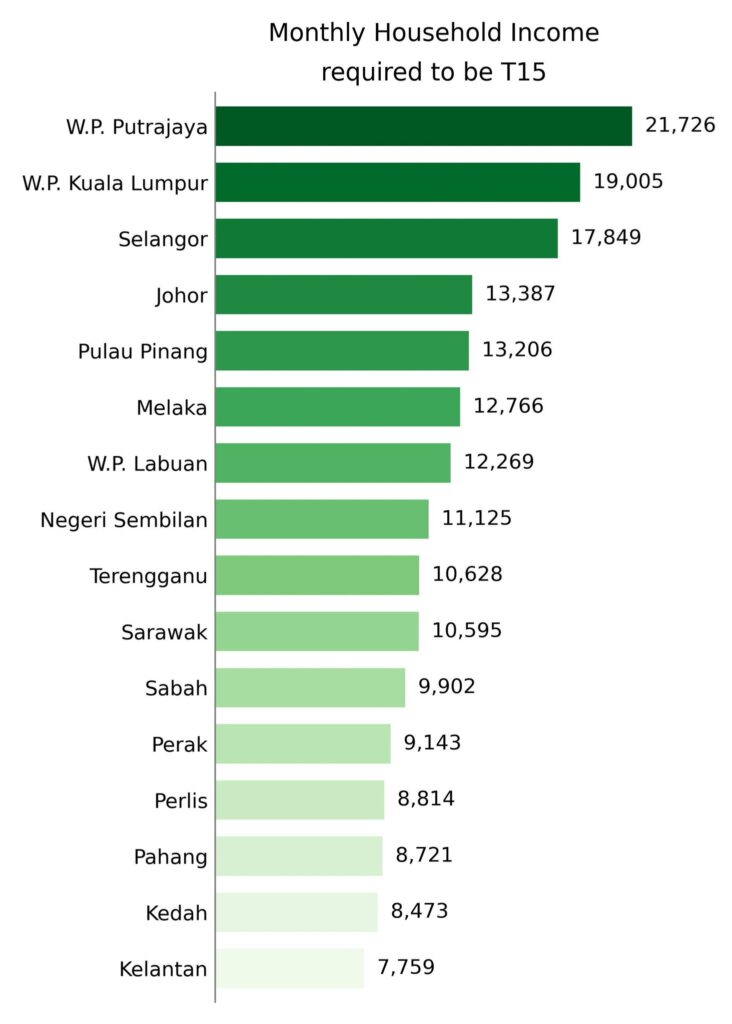T15 is a term introduced in Malaysia’s new Bajet (Budget) 2025, referring to the top 15% of households by income. As of October 2024, households earn approximately RM13,000 or more per month. This classification is part of the government’s efforts to implement more targeted policies and subsidy reforms.
T15 Income Group Malaysia
What is the T15 income group in Malaysia?
The T15 income group in Malaysia refers to the top 15% of households by income. This term was introduced in the new Bajet (Budget) 2025 as part of the government’s efforts to implement more targeted policies and subsidy reforms.
What is the T15 income range in Malaysia?
The T15 income range in Malaysia generally starts at approximately RM13,000 per month for households. However, this threshold varies significantly across different states and territories. For example, in W.P. Putrajaya, the threshold is as high as RM21,726 per month, while in Kelantan, it’s as low as RM7,759 per month.
How is T15 income calculated?
In a typical dual-income household within the T15 bracket, each spouse might earn around RM6,500 per month. However, the actual income threshold for T15 varies significantly across different states and territories in Malaysia.
What are the differences between T15 and T20 Income?
T15 is a subset of T20, which refers to the top 20% of Malaysian households earning from RM11,820 monthly. T15 represents a more exclusive group within T20, generally starting around RM13,000 monthly but varying by state.
The table below compares the T20 and T15 income groups, highlighting their critical differences in definition, income thresholds, subgroups, regional variation, and policy context.
| Aspect | T20 | T15 |
|---|---|---|
| Definition | Top 20% of households | Top 15% of households |
| Income Threshold | Starts at RM11,820/month | Generally around RM13,000/month |
| Subgroups | T1 (RM11,820 – RM15,869) and T2 (RM15,870 and above) | No specified subgroups |
| Regional Variation | Not available | Varies by state (RM7,759 – RM21,726) |
| Policy Context | General income classification | Introduced in Budget 2025 for targeted policies |
How does the T15 threshold vary across Malaysia?
The income required to be considered T15 varies across different states and territories in Malaysia. According to the data, W.P. Putrajaya has the highest threshold at RM21,726 per month, followed closely by W.P. Kuala Lumpur at RM19,005 and Selangor at RM17,849. These higher thresholds in major urban areas contrast sharply with other regions.

Johor and Pulau Pinang have similar thresholds at RM13,387 and RM13,206, respectively, while Melaka and W.P. Labuan fall slightly below RM12,766 and RM12,269. Moving down the list, we see Negeri Sembilan at RM11,125, followed by Terengganu and Sarawak with very close figures of RM10,628 and RM10,595.
The threshold continues to decrease for other states, with Sabah at RM9,902, Perak at RM9,143, Perlis at RM8,814, and Pahang at RM8,721. The lowest thresholds are found in Kedah at RM8,473 and Kelantan at RM7,759. The government must consider local economic conditions when implementing policies targeting the T15 group across Malaysia.
Why are these regional variations for T15 income significant?
These regional variations of T15 income reflect the country’s diverse economic landscape and highlight the importance of considering local contexts when implementing national policies targeting the T15 group. They also demonstrate that being classified as T15 doesn’t necessarily mean the same level of financial comfort across all parts of Malaysia.
How do I calculate whether I am in the T15 income group?
To determine if you’re in the T15 income group, you should:
- Calculate your total household monthly income.
- Compare it to the threshold for your specific state or territory.
- If your household income is at or above the threshold for your area, you’re likely in the T15 group.
For example, if you live in Selangor and your household earns RM17,849 or more per month, you would be considered part of the T15 group in that state.
Is there any calculator to find out about the T15 income range?
No, there is no specific calculator for determining T15 status. However, you can use the data provided for different states to compare your household income against the threshold for your area. If you need a more precise determination, it would be best to check with official Malaysian government sources or financial advisors who might have access to more detailed calculators or up-to-date information.
What is T20?
T20 (Top 20%) refers to Malaysia’s highest-earning 20% of households. It is divided into two subgroups (T1 and T2), with monthly household incomes starting at RM11,820 and T2 representing all households earning RM15,870 and above. The median income for T1 is RM13,475, while for T2 it is RM20,776. T20 households are generally considered affluent and may be subject to policies to ensure they contribute proportionately to national development, such as reduced subsidies or increased fees for certain public services.
What is M40?
M40 (Middle 40%) represents the middle 40% of Malaysian households by income. This group is categorized into four subgroups (M1 to M4) with monthly household incomes ranging from RM5,250 to RM11,819. M40 households have median incomes between RM5,770 and RM10,552, varying by subgroup. This segment is considered the core of Malaysia’s middle class and is often the focus of policies designed to strengthen the country’s economic foundation and promote upward mobility.
What is B40?
B40 (Bottom 40%) refers to the lowest 40% of households by income in Malaysia. This group is divided into four subgroups (B1 to B4) with monthly household incomes ranging from less than RM2,560 to RM5,249. Depending on their subgroup, B40 households typically have median incomes between RM2,012 and RM4,764. These households are often the primary beneficiaries of government assistance programs and subsidies to improve living standards and reduce income inequality.
Share Your Salary Anonymously
Help create salary transparency by sharing your information. We respect your privacy and do not collect any personal details. Your contribution helps others in the industry make informed career decisions.

